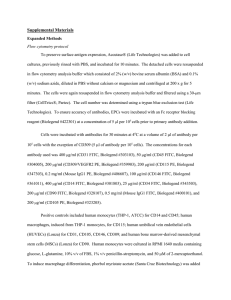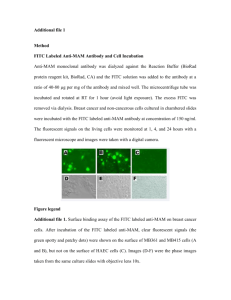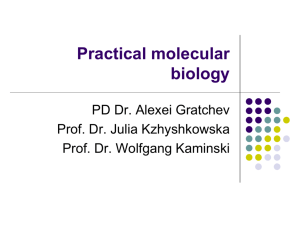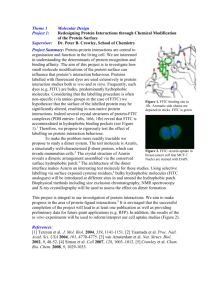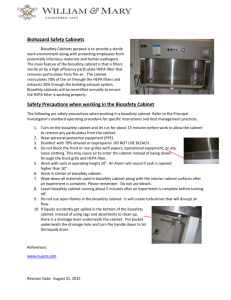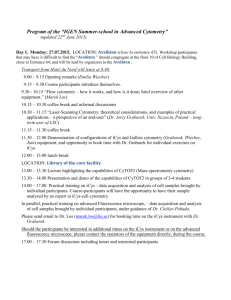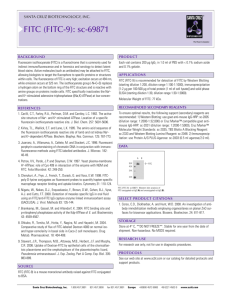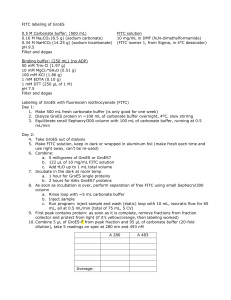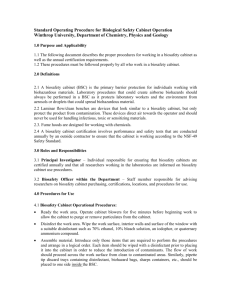Cell Culture Principles and Techniques
advertisement
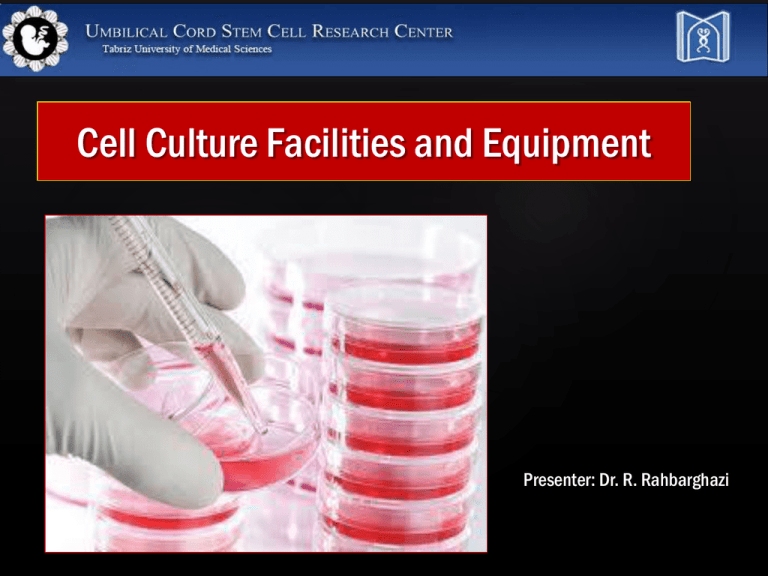
Cell Culture Facilities and Equipment Presenter: Dr. R. Rahbarghazi Small Tissue Culture Laboratory suggested for use by two or three persons Medium-Sized Tissue Culture Laboratory suitable for five or six persons Tissue Culture Lab with Adjacent prep room with medium-sized tissue culture lab Large Tissue Culture Laboratory; suitable for 20 to 30 persons High-Efficiency Particulate Air (HEPA) Equipment 1. 2. 3. 4. 5. 6. 7. 8. 9. Laminar flow hood (Biological safety cabinet) CO2 incubator (for most cells) Inverted Microscope Pipette aid Aspiration pump Centrifuge Water bath Cold storage Cryopreservation Additional or Optimal Equipment 1. 2. 3. 4. 5. 6. 7. 8. 9. Sterilization equipment Balances Vortex Water purification pH meter Magnetic stirrer Micro pippettor Cell counter Video camera or CCD camera Laminar flow hood (Biological safety cabinet) 1. Vertical mode 2. Horizontal mode Vertical laminar flow hoods 1. 2. 3. Class I biosafety cabinet Class II biosafety cabinet Class III biosafety cabinet Class I Biosafety Cabinet 1. 2. 3. 4. Air is circulated away from operator 100% of air is exhausted Is optimal for radionuclides and volatile (toxic) materials Dirty room air contaminates materials Class II Biosafety Cabinet Type II-A 1. A front access opening with a carefully maintained inward flow 2. HEPA-filtered unidirectional airflow 3. HEPA-filtered exhaust air to the lab (30%) 4. 70% of the air re-circulated back into the laminar flow hood 5. Are not suitable for wok with radionuclides or volatile materials Type II B 1. Are conducted to exterior of building 2. Air are not re-circulated within the cabinets 3. Suitable for work with radionuclides and volatile materials Class III Biosafety Cabinets 1. 2. 3. 4. Providing highest level of protection for both material and operator Is totally enclosed Is under negative pressure 100% of air is exhausted CO2 and N2 incubators Inverted Microscope Inverted microscope Stereo or dissecting microscope Fluorescent inverted microscope Confocal microscopy Pipette aid Aspiration (vacuum) pump Stirrer Flask Bioreactors Centrifuge Cold storage Cryopreservation Sterilization equipment Micro-filters Glass vacuum filtration Balances Vortex Water bath Water Purification Flow cytometry Flow cytometry integrates electronics, fluidics, computer, optics, software, and laser technologies in a single platform 1. 2. Advantages: Provides individual measurements of cell fluorescence and light scattering Enables us to individually sort or separate subpopulations of cells Fluorescence Activation Process (or Immunofluorescence) Antibodies recognize specific molecules in the surface of some cells, especially stem cells FITC Antibodies are artificially conjugated to fluorochromes (PE, FITC, RH, Alexa flour , … FITC Antibodies FITC FITC But not others When the cells are analyzed by flow cytometry the cells expressing the marker for which the antibody is specific will manifest fluorescence. Cells who lack the marker will not manifest fluorescence Cellular Parameters Measured by Flow Intrinsic No reagents or probes required (Structural) Cell size (Forward Light Scatter) Cytoplasmic granularity (90 degree Light Scatter) Photsynthetic pigments Extrinsic Reagents are required 1. Structural DNA content DNA base ratios RNA content 2. Functional Surface and intracellular receptors. DNA synthesis DNA degradation (apoptosis) Cytoplasmic Ca++ Gene expression Flow Cytometry Applications Immunofluorescence Cell Cycle Kinetics Cell Kinetics Genetics Molecular Biology Animal Husbandry (and Human as well) Microbiology Biological Oceanography Parasitology Bioterrorism FSC Correlates With Cell Size SSC Correlates With Internal Complexity • Fluorochromes Are Molecules That Emit Fluorescence Upon Excitation With Light – – – – FITC (Fluorescein Isothiocyanate) PE (Phycoerythrin) PerCP (Peridinin Chlorophyll Protein) APC (Allophycocyanin) • Some Fluorochromes Are Proteins, Some Are Small Organic Compounds – Ex. PE (Phycoerythrin)-Protein – Ex. FITC (Fluorescein Isothiocyanate) Emission Spectra Excitation Spectra Magnetic-Activated Cell Sorting (MACS)
